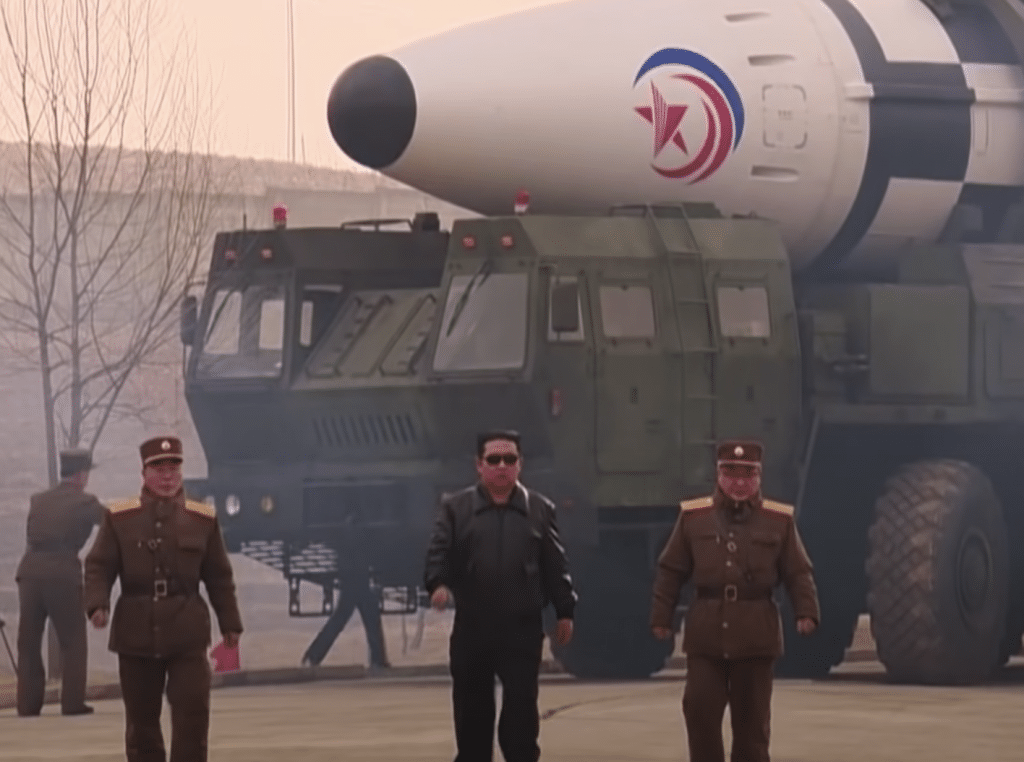North Korea tests a banned missile—and glamorizes nuclear weapons
By Susan D’Agostino | March 24, 2022
 North Korea’s state television released a propaganda video about its recent missile launch featuring Kim Jong Un. Screenshot accessed via Korea Now, the official YouTube Channel of the Yonhap News Agency, from the embedded video below. Yonhap is funded in whole or in part by the Korean government.
North Korea’s state television released a propaganda video about its recent missile launch featuring Kim Jong Un. Screenshot accessed via Korea Now, the official YouTube Channel of the Yonhap News Agency, from the embedded video below. Yonhap is funded in whole or in part by the Korean government.
This story was updated on March 25, 2022.
North Korea launched what is presumed to be a banned intercontinental ballistic missile (ICBM) toward the East Sea on Thursday, according to South Korea’s Yonhap News Agency, marking an “end to its self-imposed moratorium on nuclear and long-range missile testing.” Though Pyongyang has conducted other missile tests this year, this test involved what appeared to be the most powerful missile North Korea has launched. The test comes during a time when the world’s gaze has been fixed on Russia’s war in Ukraine, which just entered its second month.
“This launch is a brazen violation of multiple UN Security Council resolutions and needlessly raises tensions and risks destabilizing the security situation in the region,” White House Press Secretary Jen Psaki said in a statement.
North Korea claimed that the missile was a Hwasong-17—a “monster missile” according to analysts—first unveiled in a 2020 military parade. After Thursday’s launch, North Korea’s state television released a Hollywood-esque video featuring Kim Jong Un in dark sunglasses and a leather jacket, flanked by generals, in a slow-motion walk accompanied by heart-pounding music while the colossal weapon rolls out behind him. The men check their watches (who wears a watch these days?). A red light flashes and beeps, the missile launches in a cloud of exhaust and fire, and men in a control room erupt with cheers while shaking their fists. The propaganda video does not hint at the humanity-ending potential of nuclear weapons.
The missile reportedly traveled 1,080 kilometers (670 miles), reached an altitude of 6,200 kilometers (3,850 miles), and flew for 71 minutes, according to the Associated Press. If confirmed as an intercontinental ballistic missile, the incident suggests that North Korea has made significant progress in developing a nuclear weapons delivery system that could reach the United States.
“My suspicion is that the payload for this particular test may have been a single, representative dummy warhead to demonstrate maximum range,” Ankit Panda, author of Kim Jong Un and the Bomb: Survival and Deterrence in North Korea, wrote on Twitter.

Japanese Prime Minister Fumio Kishida, upon arriving in Belgium for the Group of Seven meetings focused on the war in Ukraine, called North Korea’s launch “unforgivable recklessness.”
South Korea, in a demonstration of its retaliatory capabilities, launched missiles from air, sea, and land off its east coast in response. South Korean President Moon Jae-in said that the launch represented a “breach of the suspension of intercontinental ballistic missile launches promised by Chairman Kim Jong Un to the international community.” Moon is scheduled to leave office on May 10 after losing in a tight election to incoming President Yoon Suk-yeol. The new president has promised to be tougher on North Korea and to strengthen ties with the United States.
North Korea’s nuclear arsenal has made “significant advances” in recent decades, according to Hans Kristensen and Matt Korda, both of the Nuclear Information Project at the Federation of American Scientists. Kristensen and Korda are the authors of the Nuclear Notebook, published bimonthly in the Bulletin of the Atomic Scientists. In their last column focused on North Korea, they estimated that the country “may have produced enough fissile material to build between 40 and 50 nuclear weapons; however, it may not have actually assembled that many.”

After North Korea’s 2017 missile tests, the United Nations Security Council, on which the United States, Russia, and China are permanent members, imposed dramatic sanctions on North Korea. Given the lines that have since been drawn in the war in Ukraine, cooperation on additional sanctions seems unlikely.
In the weeks leading up to Thursday’s provocation, the United States and South Korea had grown increasingly concerned about the prospect of North Korea testing an ICBM. “The door has not closed on diplomacy,” Psaki said in the White House statement, “but Pyongyang must immediately cease its destabilizing actions.”
Together, we make the world safer.
The Bulletin elevates expert voices above the noise. But as an independent nonprofit organization, our operations depend on the support of readers like you. Help us continue to deliver quality journalism that holds leaders accountable. Your support of our work at any level is important. In return, we promise our coverage will be understandable, influential, vigilant, solution-oriented, and fair-minded. Together we can make a difference.
Keywords: ICBM, North Korea, South Korea, ballistic missile, nuclear risk, nuclear weapons
Topics: Nuclear Risk, Nuclear Weapons














